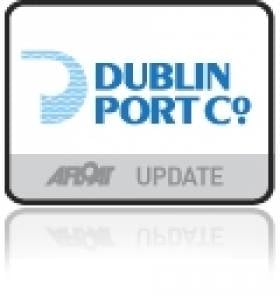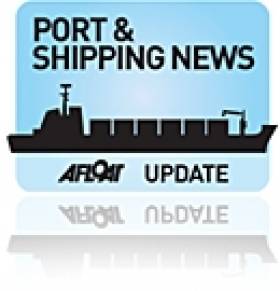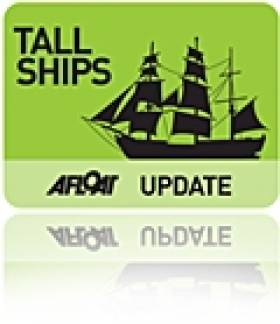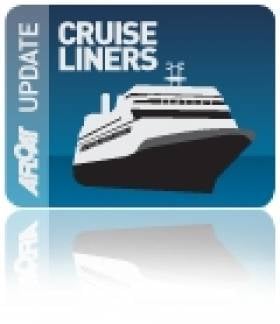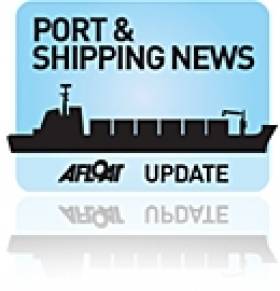Displaying items by tag: Dublin Port
Dublin Port to Pay €16.5 million Dividend to the State
At today's AGM the Annual Report for 2010 was presented to the Shareholders in advance of publication later this year after it has been laid before the Oireachtas.
Dublin Port Company also outlined its trading outlook for the remainder of the year after a return to growth in throughput in 2010 following two years of decline in trade. These results showed an increase of 6.1% on the previous year to 28.1 million tonnes which is just 9% lower than the historic high of 30.9 million tonnes in 2007.
Addressing Dublin Port Company's AGM, Ms. Lucy McCaffrey, the company's chairperson, said; "I was pleased to report to our shareholders, the representatives of the Minister for Transport and Minster for Finance, that Dublin Port Company will pay a dividend of €6.5 million in respect of the 2010 financial out-turn along with a payment of a special dividend of €10 million. The €16.5m paid this year will bring total distributions to €36.6 million in a five year period. In addition to paying a dividend to our shareholder we remain committed to investing in the port's infrastructure to ensure that Dublin Port remains the efficient modern competitive port it has become. We recently launched a major consultation exercise with all our stakeholders to create a Masterplan for the future development of Dublin Port to ensure that it can continue to serve the trading needs of the city and country for generations to come."
Speaking about the financial performance of Dublin Port Company for 2010, Dr. Leo Varadkar TD, Minister for Transport said; "I congratulate the company on its strong financial performance for 2010 which has enabled it to pay a further dividend to the State. It is encouraging that the company remains a profitable enterprise which continues to pay a dividend to the State, in line with current Government policy in relation to the commercial State companies. Furthermore, it is encouraging that the financial strength of the company will allow it to invest significantly in the future development without recourse to exchequer funding. This country's return to economic prosperity will be export-led and Irish ports will play an important role in facilitating that trade. In this regard the current Masterplan consultation process the company has embarked on is a timely and necessary exercise in preparing for the future."
Moth Dinghy Makes its Dublin Bay Sailing Club Debut
Making its debut for the first time under the club burgee was an International Moth dinghy. The ultra fast hull was airborne at just eight knots of breeze, making even the trapezing Fireballs look slow. But despite the pace the new fangled dinghy did not feature in the overall Portsmouth Yardstick (PY) results. See below.
A healthy turnout of six 'balls, urged on by the fact that the class World Championships is in Sligo in 46 days time, got some trapezing gusts and some planing waves downwind in a north-easterly breeze of 6-8 knots. S. Oram took the winning gun from Louis Smyth sailing Licence to Thrill.
Single handed Lasers boasted twice the Fireball turnout to be the biggest class racing in Scotsman's bay tonight. It's a show of strength from a class surely worthy of its own start if this kind of turnout can be maintained.
Sean Craig won the Laser race from Peter Craig but the overall PY result went to E. Ryan's RS400.
Two Dublin Bay Mermaids and disappointingly, a single IDRA 14, No.124, Squalls also competed.
DUBLIN PORT Dublin Bay Sailing Club Results for 26 APRIL 2011
FIREBALL - 1. nn (S Oram), 2. Licence to Thrill (Louis Smyth), 3. Incubus (C Power/M Barry)
MERMAID - 1. Lively Lady (G O'Neill & M Hanney), 2. Jill (P.Smith/P.Mangan)
PY CLASS - 1. E Ryan (RS400), 2. Sean Craig (Laser), 3. Peter Craig (Laser)
BENETEAU 31.7 - 1. Extreme Reality (P.McSwiney/E.O'Rafferty), 2. Magic (D.O'Sullivan/D.Espey)
BENETEAU 31.7 - 1. Magic (D.O'Sullivan/D.Espey), 2. Extreme Reality (P.McSwiney/E.O'Rafferty)
CRUISERS 2 - 1. Cor Baby (Keith Kiernan et al), 2. Red Rhum (J Nicholson), 3. Free Spirit (John O'Reilly)
CRUISERS 3 - 1. Grasshopper 2 (K & J Glynn), 2. Pamafe (Michael Costello), 3. Papytoo (M.Walsh/F.Guilfoyle)
CRUISERS 4 - 1. Maranda (Myles Kelly), 2. Ghrazel (Charles Pearson), 3. Artemis (J.Giles)
RUFFIAN 23 - 1. Diane ll (Bruce Carswell), 2. Icicle (C & J Murray), 3. Alias (D.Meeke/M.McCarthy)
SIGMA 33 - 1. Rupert (R.Lovegrove/P.Varian), 2. Pippa lV (G.Kinsman/K.Blake/M.O'Brien)
SQUIB - 1. Tais (Michael O'Connell), 2. Periguin (N.Coakley/J.Redahan)
More DBSC News here.
Ulysses Celebrates 10 Years of Irish Sea Service
In January 2000 the keel of the worlds largest car ferry was laid at the Aker Finnyards in Rauma, Finland. The following year the €100m cruiseferry giant departed the shipyard on a four-day delivery voyage to Dublin Port. Upon Ulysses's arrival on 4th March she was presented with a traditional welcoming escort of saluting water-firing tugs.
The Ulysses was named at a ceremony in the port on 21st March by the 'golden godmother' Mairead Berry, Ireland's 25-year old Paralympic Games gold medallist. Four days later Ulysses made her commercial maiden voyage to Holyhead on 25th March.
Wih 12 decks the vessel has an extensive range of facilities and they are named with themes derived from James Joyce's famous novel 'Ulysses'. There is seating available for up to 1,938 passengers and there are 117 twin or single-cabins, accommodating up to 228 passengers.
Only two months into service the Ulysses won the prestigious 'Most Significant New Build - Ferry' category award in the Cruise & Ferry magazine 2001 Awards competition. Her Finnish builders are not only builders of large cruise-ferries for Baltic Sea operators and beyond but also are also renowned for the construction of very large cruiseships for international clients.
Ulysses was designed specifically to serve the central corridor route with a schedule of two round trips daily. She directly replaced the 1997 Dutch built 34,031 grt ro-pax Isle of Inishmore, which transferred to Rosslare-Pembroke Dock service.
In 2006 the Ulysses alongside her fleetmates were transferred from the Irish flag to the Cypriot flag in addition to a change of Irish crew with those outsourced from citizens mostly from the Baltic and Eastern European countries.
Due to the sheer size of the Ulysses, which has a length of 209m, a beam of nearly 32m and a 6.4m draught, she has not missed a single crossing due to bad weather conditions. The vessel has a 22 knot / 41kph service -speed on the 60-mile route which translates to a distance of over 182,000 kms a year.
To celebrate Ulysses 10th year in service, Irish Ferries has enhanced the Club Class option to passengers which includes free-Wifi, which enables a constant connection and an array of other benefits during the 3-hour 15 minute crossing.
For a virtual tour of the Ulysses with views taken from the top deck as the cruiseferry departs Holyhead and the mountains of Snowdonia setting as a backdrop plus interior tours of the vessel click here.
Expansion Is The Only Way Says Dublin Port Chief
Trade at Dublin Port is set to more than double over the next 30 years, according to its chief executive Eamonn O'Reilly.
In an interview with The Irish Times last week, O'Reilly elaborated on the new 'master plan' for the port, which is based on an estimated trade growth to 60 million tonnes (or 2.5% annually) by 2040.
“Last year’s growth [of 6.1%] suggests to me that we need to get our planning caps on and get a solid and robust master plan in place,” said O’Reilly.
The master plan, according to the Dubin Port chief, will require expansion of the existing port by reclaiming up to 40 hectares, as well as a greater integration with bordering areas.
Previous attempts to expand have faced much opposition from conservation groups and local residents for a number of years.
O’Reilly stressed that the local community will be engaged on the issues involved before Dublin Port produces a final proposal at the end of the year.
But he also insisted that "there’s no project [that hee knows of] for port expansion that doesn’t involve reclamation", despite proposals to establish a new port at Bremore.
Read more of the Irish Times interview with Eamonn O'Reilly HERE.
Tripartite Naval Visitors for Dublin Port
Naval vessels from France, Canada and Belgium are due to make calls to Dublin Port over the weekend, writes Jehan Ashmore.
The first visitor to dock tomorrow will be the Latouche-Tréville (D646) a F70 type anti-submarine frigate of the French Marine Nationale. She is one of seven F70 ASM class anti-submarine frigates and is capable of carrying two 2 Lynx helicopters. In June 2010 the frigate visited London where the 1984 built 3,550 tonnes vessel moored alongside the WW II cruiser, HMS Belfast.
Also due to arrive tomorrow is the Canadian Navy's HMCS St. John's which too is to berth at Ocean Pier. HMCS St. John's (340) is the eleventh 'Halifax' class frigate, measuring some 4,770 tonnes. The multi-role patrol frigate was commissioned in 1996 in St. John's, Newfoundland and is designed to perform three distinct functions: anti-submarine warfare, anti-air warfare and anti-surface warfare.
On Sunday the third international naval visitor to Dublin Port will be the Belgium Navy's Léopold I (F930). This frigate is based in the Quartier Naval Base in Zeebrugge and in 1997 she was commissioned into service in a ceremony by Belgium's Queen Fabiola.
The 2,800 tonnes frigate is capable of taking two helicopters and the vessel can cruise at 21 knots using two diesel engines or is capable of reaching a top speed of 30 knots based from gas turbine power-plants. Léopold I has participated in NATO's Response Force (NRF). For a detailed visual discription of equipment click this link here
First Cruise-Caller of the Year
Onboard the ship which caters mostly for the UK market, asides the interior facilities there are the outdoor leisure amenities located on the Lounge Deck which has two jacuzzis and an exercise pool. There is also a large swimming pool and weather permitting a poolside buffet is also available at meal times. In addition a circular pool is located on the Marque Deck.
She alongside sister Black Watch belong to a four-ship fleet of the Norwegian owned company. Boudicca was built in 1973 and for many years served as Royal Viking Star as part of a trio of German built sisters for Royal Viking Line. The 205m long vessel underwent her last major refit in 2006.
Boudicca will remain berthed in Dublin's Alexandra Basin until she sets sail later this afternoon for the short overnight cruise-leg to Liverpool.
Last year Dublin Port handled 88 cruisecalls and this number of cruise-callers is to be closely repeated in 2011. Overall there will be over 200 cruise calls with around half a million passengers and crew scheduled to visit ports and anchorage locations throughout the island of Ireland. The cruise sector business is estimated to generate €60m to both the northern and southern economies.
Irish Sea 'Racehorse' Returns
Dawn Merchant and Brave Merchant represented the first pair of the 'Racehorse' class quartet of ro-pax sisters commissioned for the Cenargo Group. The quartet were built by Spainish shipbuilders Astilleros Espanoles SA in Seville, noting the first pair at 22,046grt where slightly smaller in tonnage terms compared to their 22,215grt counterparts Midnight Merchant and Northern Merchant. Upon delivery in 2000 the second pair were chartered to Norfolkline's Dover-Dunkerque route.
With a 130 truck capacity the Norman Trader can handle a marginally higher number of freight vehicles compared to the Norcape which handled 127 trucks. The Norcape, a 32-year-old freight-only vessel,was stood down in February and remains laid-up at Liverpool's Huskisson Dock. Incidentally, Norman Trader has joined one of her Racehorse class sisters, European Endeavour (formerly Midnight Merchant) which had directly replaced the Norcape on the central corridor route.
Likewise the European Endeavour is no stranger to the Irish route as for the last two years she has acted as winter relief vessel to cover the refits of the routes Dutch built ro-pax sisters Norbay and Norbank. The latter vessel is now undergoing a refit by Cammell Laird Shiprepairers in Birkenhead, now that the Norman Trader is in service to maintain the three-ship operated 8-hour route.
The Norman Trader had arrived into Dublin Bay last Friday from London's Tilbury Docks, on the next day she entered Dublin Port. In recent years she has operated on English Channel routes for the French shipping giant Louis-Dreyfus Armateurs through their ferry division LD Lines.
Norman Trader's (Dawn Merchant) sister Brave Merchant now renamed Norman Bridge also runs for LD Lines 'Motorways of the Seas' (MOS) route across the Bay of Biscay between Nantes /St. Nazaire to Gijón in northern Spain. The 14-hour route which started last year, which was run iniatially as a joint venture between Grimaldi Lines and Louis-Dreyfus and traded as GLD Atlantique.
- Dublin Port
- Bay of Biscay
- irish sea
- Ports and Shipping News
- Birkenhead
- Norcape
- RoPax
- DublinLiverpool
- Norfolkline
- FreightFerry
- Motorways of the Sea
- Norbank
- Norbay
- MOS
- European Endeavour
- Central Corridor
- P&O Irish Sea
- Norman Trader
- LD Lines
- Merchant Ferries
- Cenargo Group
- RaceHorse Class
- Tilbury Docks
- Cammell Laird
- Aintree
- Grand National
- Aintree Grand National
Bursaries Announced as Tall Ship Sailing Creates a Buzz
There's a real sailing buzz around Tall Ships these days, even though Ireland does not currently have one to sail. There's less than 100 days to the Tall Ships visit to Waterford, last weekend saw a ground breaking Tall Ships Conference, a sailing School has offered a Sloop as a temporary replacement and this morning the Irish Sailing Association has announced 1000 Euro bursaries to get young people involved in Tall Ship sailing.
Last weekend's workshop in Dublin Port was a great success with Tall Ship Chairmen from Dublin, Belfast, Cork and Galway all in attendance. Now the ISA is going on further with the immediate announcement of the launch of Sail Training Ireland, again in Dublin Port in two weeks time.
Following the sinking of the Asgard II and the decision to wind up Coiste An Asgard, the ISA (Irish Sailing Association) has facilitated a steering group with the establishment of 'Sail Training Ireland', an umbrella organisation developing a national sail training programme in Ireland. Sail Training Ireland, now incorporated as a limited company, is to be launched on Thursday the 14th of April 2011 in Dublin Port offices at 12:30pm. All those with an interest in Sail Training activities are very welcome to attend.
Sail Training International has awarded a bursary to Sail Training Ireland which will provide funding to support the participation of young people in The Tall Ships Races 2011 and 2012. Sheila Tyrrell, Chair of the steering group, who has a long history with sail training and in particular the Asgard remarked "We are delighted that we are in a position to formally launch the association, we are now taking applications for bursaries to allow young people to participate in the Tall Ships Race visiting Waterford later this year, and are also recruiting a manager to help manage the affairs of the association."
The aims and objectives of Sail Training Ireland are to promote the development and education of young men and women through the Sail Training experience regardless of nationality, culture, religion, gender or social background as well as to sponsor and support sea-going trainees. Sail Training Ireland will also engage with Sail Training International to establish a recurring Sail Training Ireland endorsed Tall Ships Maritime Festival every three to five years.
There will be a number of bursaries of up to a maximum of €1,000 available, towards the cost of the voyage. Each bursary shall not be more than 50% of the total cost of participation i.e. cost of the berth plus any travel expenses. Applicants should apply in writing using the application form published on www.irishsailtraining.com . Applications must be received by 30 April 2011.
Sail Training Ireland is also seeking to appoint a part-time manager to help with the development of a business plan and the day to day running of the organisations affairs. Further information on the position and a full job description can be found on the STI website www.irishsailtraining.com. Closing date for applications is Friday 22nd April, just three weeks away.
The launch, sponsored by Arklow Shipping, is to be hosted by Dublin Port who are one of a number of ports supportive of the project.
Looking for further reading on Tall Ships in Ireland? Click the links below:
Click this link to read all our Tall Ships Stories on one handy page
Previewing Ireland's Tall Ships 2011 Season
Can Ireland Get a New Tall Ship?
Cruise-Callers Set to Start Summer Season
Dublin Port last year had 88 cruisecalls and this number of vessels is to be closely repeated in 2011. One of the calls will be Princess Cruises 3,100 passenger Grand Princess. This was the first cruiseship of over 100,000grt to dock at Dublin which arrived on 31 August 2004 (click for photo on the day) and to read more about the cruiseship industry in Ireland from the IMDO click here.
Outside the capital the following vessels outlined are the first cruiseships to call at other ports in April. The season runs to September, though in recent years occasional calls are still made up to November.
The first cruise-caller at Waterford is Quark Expeditions adventure exploration vessel Ocean Nova. At only 2,118 tonnes the diminutive vessel is only 73m long and equally has the same number of passengers and a crew of 38.
Built in 1992 the polar adventure vessel has an ice-strengthened hull to enable the exploration of the icy waters of Greenland, the Weddell Sea and the Antarctic. A pair of Zodiac craft are provided for shore-landings.
The hosting of the Waterford Tall Ships Race Festival has led to funding of €1.7m from Failte Ireland to upgrade the city-centre's Frank Cassin Wharf. This will allow the large 'A' class tallships to berth and will be a lasting legacy of the festival. The wharf will then be used to berth cruiseships and other marine users. In total the crystal city is to welcome 12 callers to include the Crystal Serenity in July.
Cork is set to welcome 54 cruisecalls to include the return of the Cunard Line's 90,000grt Queen Victoria which made her first call to Cobh last year. The 2007 built vessel has a guest capacity for 2,000. The Cunard flagship Queen Mary is scheduled mid-September.
The deepwater berth at Cobh Cruise Terminal is capable of handling some of the largest cruiseships and which will see the return of the 122,000grt Celebrity Eclipse also in April.
Celebrity Eclipse made her maiden cruise and port of call to Cobh last year following her high profile repatriation voyage from Spain with stranded UK tourists arising from the fallout of the Icelandic volcanic ash-cloud. The 2,850 passenger €500m cruiseship which made an overnight call at Cobh during the May Bank holiday weekend.
From the south to the north at Belfast, the port's first caller on 24 April is the Ocean Nova which makes another appearance on the Irish cruiseship scene.
Belfast Harbour Commissioners have developed the 1km long Stormont Wharf to attract increasingly larger cruiseships to the city. The Ocean Nova's visit will mark over a dozen years since the first cruiseship docked in the northern capital.
In 2011 Belfast is scheduled to accommodate 30 cruise-calls bringing over 50,000 passengers to the city and surrounding environs.
All three visiting vessels were to be made open to the public over the weekend while berthed alongside the Deep Water (Coal) Quay downriver of the East-Link Toll-Lift road bridge.
FGS Brandenburg is the leadship of the Type-123 'Brandenburg' class. For a photo of the 4,900 tonnes frigate arriving in the Grand Harbour in Valleta, the capital of Malta (in 2004) click here.
The 20,240 displacement tonnes FGS Berlin is also the leadship of her namesake class of auxiliary fuel replenishment/stores-ship. The 174-metre long Berlin class ship (see photo) also has the capability to convey containers. The last of the trio, FGS Rheinland-Pfalz (photo) is a Bremen class frigate of 3,680 tonnes.
Since the Libyan crisis started in late February, the Maltese capital has been frequently used as a strategic transitional hub-port for naval vessels, including several calls by the UK's Type 22 frigate HMS Cumberland (F85). Earlier this month the Type 42 destroyer HMS York (D98) was also conducted to assist fleeing UK and foreign nationals from Benghazi.
In addition to other navies, Valletta has been used by ferries chartered by governments to assist in the evacuation of thousands of fleeing foreigners, mostly from Europe, though many other emigrants from Africa and Asia remain stranded.


























